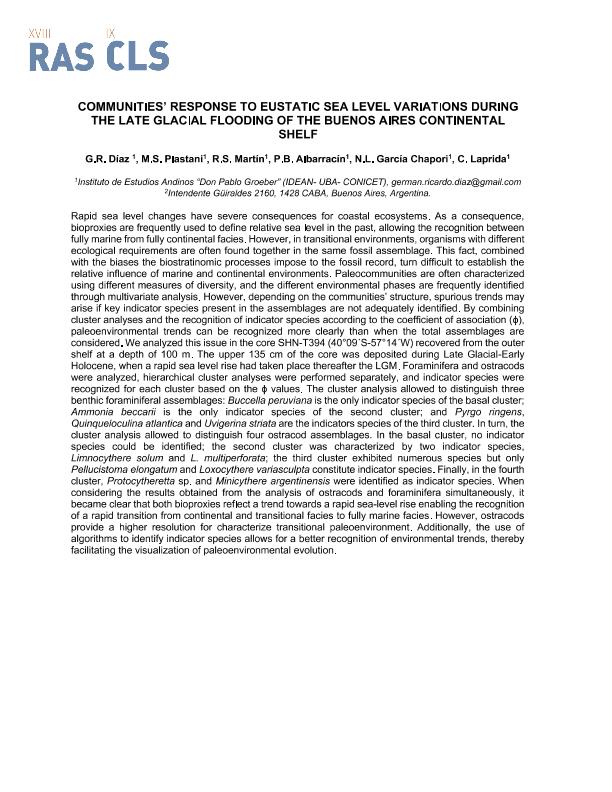Mostrar el registro sencillo del ítem
dc.contributor.author
Díaz, Germán Ricardo

dc.contributor.author
Plastani, María Sofía

dc.contributor.author
Martín, Rodrigo Sebastian

dc.contributor.author
Albarracin, Paula Belen

dc.contributor.author
García Chapori, Natalia Luz

dc.contributor.author
Laprida, Cecilia

dc.date.available
2024-01-10T09:40:21Z
dc.date.issued
2023
dc.identifier.citation
Communities’ response to eustatic sea level variations during the late glacial flooding of the buenos aires continental shelf; XVIII Reunión Argentina de Sedimentología y IX Congreso Latinoamericano de Sedimentología; La Plata; Argentina; 2023; 121-121
dc.identifier.isbn
978-631-90299-0-1
dc.identifier.uri
http://hdl.handle.net/11336/223107
dc.description.abstract
Rapid sea level changes have severe consequences for coastal ecosystems. As a consequence, bioproxies are frequently used to define relative sea level in the past, allowing the recognition between fully marine from fully continental facies. However, in transitional environments, organisms with different ecological requirements are often found together in the same fossil assemblage. This fact, combined with the biases the biostratinomic processes impose to the fossil record, turn difficult to establish the relative influence of marine and continental environments. Paleocommunities are often characterized using different measures of diversity, and the different environmental phases are frequently identified through multivariate analysis. However, depending on the communities’ structure, spurious trends may arise if key indicator species present in the assemblages are not adequately identified. By combining cluster analyses and the recognition of indicator species according to the coefficient of association (ϕ), paleoenvironmental trends can be recognized more clearly than when the total assemblages are considered. We analyzed this issue in the core SHN-T394 (40°09´S-57°14´W) recovered from the outer shelf at a depth of 100 m. The upper 135 cm of the core was deposited during Late Glacial-Early Holocene, when a rapid sea level rise had taken place thereafter the LGM. Foraminifera and ostracods were analyzed, hierarchical cluster analyses were performed separately, and indicator species were recognized for each cluster based on the ϕ values. The cluster analysis allowed to distinguish three benthic foraminiferal assemblages: Buccella peruviana is the only indicator species of the basal cluster; Ammonia beccarii is the only indicator species of the second cluster; and Pyrgo ringens, Quinqueloculina atlantica and Uvigerina striata are the indicators species of the third cluster. In turn, the cluster analysis allowed to distinguish four ostracod assemblages. In the basal cluster, no indicator species could be identified; the second cluster was characterized by two indicator species, Limnocythere solum and L. multiperforata; the third cluster exhibited numerous species but only Pellucistoma elongatum and Loxocythere variasculpta constitute indicator species. Finally, in the fourth cluster, Protocytheretta sp. and Minicythere argentinensis were identified as indicator species. When considering the results obtained from the analysis of ostracods and foraminifera simultaneously, it became clear that both bioproxies reflect a trend towards a rapid sea-level rise enabling the recognition of a rapid transition from continental and transitional facies to fully marine facies. However, ostracods provide a higher resolution for characterize transitional paleoenvironment. Additionally, the use of algorithms to identify indicator species allows for a better recognition of environmental trends, thereby facilitating the visualization of paleoenvironmental evolution.
dc.format
application/pdf
dc.language.iso
eng
dc.publisher
Asociación Argentina de Sedimentología
dc.rights
info:eu-repo/semantics/openAccess
dc.rights.uri
https://creativecommons.org/licenses/by-nc-sa/2.5/ar/
dc.subject
Paleoceanografía
dc.subject
Paleoecología
dc.subject
Foraminífera
dc.subject
Ostracoda
dc.subject.classification
Oceanografía, Hidrología, Recursos Hídricos

dc.subject.classification
Ciencias de la Tierra y relacionadas con el Medio Ambiente

dc.subject.classification
CIENCIAS NATURALES Y EXACTAS

dc.title
Communities’ response to eustatic sea level variations during the late glacial flooding of the buenos aires continental shelf
dc.type
info:eu-repo/semantics/publishedVersion
dc.type
info:eu-repo/semantics/conferenceObject
dc.type
info:ar-repo/semantics/documento de conferencia
dc.date.updated
2024-01-08T13:15:20Z
dc.journal.pagination
121-121
dc.journal.pais
Argentina

dc.journal.ciudad
la Plata
dc.description.fil
Fil: Díaz, Germán Ricardo. Consejo Nacional de Investigaciones Científicas y Técnicas. Oficina de Coordinación Administrativa Ciudad Universitaria. Instituto de Estudios Andinos "Don Pablo Groeber". Universidad de Buenos Aires. Facultad de Ciencias Exactas y Naturales. Instituto de Estudios Andinos "Don Pablo Groeber"; Argentina
dc.description.fil
Fil: Plastani, María Sofía. Consejo Nacional de Investigaciones Científicas y Técnicas. Oficina de Coordinación Administrativa Ciudad Universitaria. Instituto de Estudios Andinos "Don Pablo Groeber". Universidad de Buenos Aires. Facultad de Ciencias Exactas y Naturales. Instituto de Estudios Andinos "Don Pablo Groeber"; Argentina
dc.description.fil
Fil: Martín, Rodrigo Sebastian. Consejo Nacional de Investigaciones Científicas y Técnicas. Oficina de Coordinación Administrativa Ciudad Universitaria. Instituto de Estudios Andinos "Don Pablo Groeber". Universidad de Buenos Aires. Facultad de Ciencias Exactas y Naturales. Instituto de Estudios Andinos "Don Pablo Groeber"; Argentina
dc.description.fil
Fil: Albarracin, Paula Belen. Consejo Nacional de Investigaciones Científicas y Técnicas. Oficina de Coordinación Administrativa Ciudad Universitaria. Instituto de Estudios Andinos "Don Pablo Groeber". Universidad de Buenos Aires. Facultad de Ciencias Exactas y Naturales. Instituto de Estudios Andinos "Don Pablo Groeber"; Argentina
dc.description.fil
Fil: García Chapori, Natalia Luz. Consejo Nacional de Investigaciones Científicas y Técnicas. Oficina de Coordinación Administrativa Ciudad Universitaria. Instituto de Estudios Andinos "Don Pablo Groeber". Universidad de Buenos Aires. Facultad de Ciencias Exactas y Naturales. Instituto de Estudios Andinos "Don Pablo Groeber"; Argentina
dc.description.fil
Fil: Laprida, Cecilia. Consejo Nacional de Investigaciones Científicas y Técnicas. Oficina de Coordinación Administrativa Ciudad Universitaria. Instituto de Estudios Andinos "Don Pablo Groeber". Universidad de Buenos Aires. Facultad de Ciencias Exactas y Naturales. Instituto de Estudios Andinos "Don Pablo Groeber"; Argentina
dc.relation.alternativeid
info:eu-repo/semantics/altIdentifier/url/https://www.ras2023laplata.com/_files/ugd/0306a6_7fd69ea257d34faf86f5d4d284533dc9.pdf
dc.conicet.rol
Autor

dc.conicet.rol
Autor

dc.conicet.rol
Autor

dc.conicet.rol
Autor

dc.conicet.rol
Autor

dc.conicet.rol
Autor

dc.coverage
Internacional
dc.type.subtype
Reunión
dc.description.nombreEvento
XVIII Reunión Argentina de Sedimentología y IX Congreso Latinoamericano de Sedimentología
dc.date.evento
2023-09-19
dc.description.ciudadEvento
La Plata
dc.description.paisEvento
Argentina

dc.type.publicacion
Book
dc.description.institucionOrganizadora
Asociación Argentina de Sedimentología
dc.source.libro
Actas de la XVIII Reunión Argentina de Sedimentología y IX Congreso Latinoamericano de Sedimentología
dc.date.eventoHasta
2023-09-22
dc.type
Reunión
Archivos asociados
